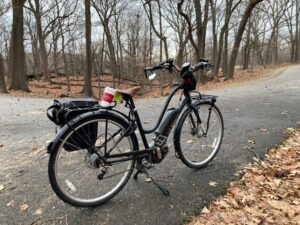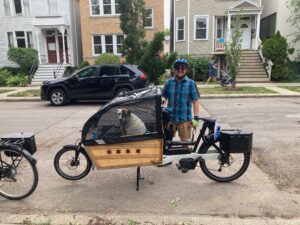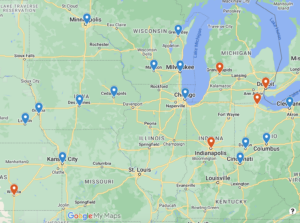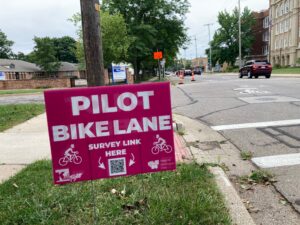Electric cargo bike, Chicago
March 20, 2023
What’s The Deal with E-bikes?
Electric bicycles are booming across the Midwest, offering surprising potential for more sustainable transportation.
How we get around can have a big impact on the planet, public health, and your pocketbook. The transportation sector is the leading source of carbon emissions in the Midwest, mainly fueled by gas cars. Public transit and electric vehicles are great alternatives, but not everyone lives near transit, and a new car isn’t the right solution for everyone. In the past few years, electric bicycles have burst onto the market, filling a different niche than other modes of travel.

Commuter e-bike
Riders can get around quickly, transport kids and cargo, and travel farther with less effort than traditional bikes or walking. An e-bike can be a great last-mile option for someone who lives far from public transportation, and it costs a lot less than a car. Cities, states, and even utilities are exploring e-bike rebates as cost-effective solutions to reduce transportation emissions and congestion. Both Illinois and Minnesota recently introduced state bills to incentivize e-bikes. At ELPC, we’re interested in climate solutions of all sizes, so we investigated e-bikes’ environmental impacts and some opportunities ahead.
What is an e-bike?
Most electric bicycles look and ride like other bikes. Riders still pedal and brake like usual, they just get a little more umph to go farther, carry more, and overcome difficult terrain or physical challenges. Class 1 e-bikes are speed-limited to 20 miles an hour, and they have pedal-assisted motors that engage only when the rider pedals the bike.

Cargo bike carrying a dog
Riders have the same rights and responsibilities as folks riding normal bikes on our roads and trails, and you can usually purchase, service, and repair them at your local bike shop. Some have longer front or back sections that help riders carry kids or groceries, known as cargo bikes.
Class 2 e-bikes have throttles (so riders don’t have to pedal), and Class 3 e-bikes can go up to 28mph, but once you get into higher speeds and different specs there are a lot of other things to consider. So, let’s focus on Class 1 e-bikes which are the most popular and familiar.
Environmental Impact

E-bikes are a clean & efficient form of travel. Chart factors in the carbon impacts of manufacturing, charging, and food calories burned per mile for walkers & bikers. Click to learn more.
Electric bikes create no carbon emissions or air pollution while riding. But even if you factor in the impacts of manufacturing, electric charging, and food for the rider, an e-bike is responsible for 93% less climate impact than a fossil-fueled passenger vehicle per mile. In the chart to the right, vehicle impacts include manufacturing, transit includes train and bus average impact per passenger mile, and walking/biking numbers are based on the food impact of calories burned per mile. E-bikes and EVs factor in charging on the average American electricity mix.
52% of all trips in the US are under 3 miles. That’s a lot of trips that could be done by bike! Of course, biking isn’t for everybody, and Midwestern weather isn’t always cooperative, but the more options people have, the more we can reduce pollution in the air, wear on our roads, and traffic to make it easier for those who do need to drive.
E-bikes in the Midwest

Electric Divvy Bike, Chicago
As of 2021, an American bought an e-bike every 52 seconds, outselling EVs by 50%. Sales almost doubled in 2020 and again in 2021, hitting over a million bikes sold in 2022. This $18 billion industry supports major Midwest companies like Trek (based in Wisconsin), and hundreds of small businesses like Briar Ridge Bikes in Solon, IA, Pedal Bicycles in Kalamazoo, MI, or Joy Machines Bike Shop in Cleveland, OH.
While some people buy their own e-bikes, many also utilize bikeshare programs. 14 of the 19 Midwest cities with bikeshare systems include e-bikes along with electric scooters and traditional bikes. Bikeshare offers a great last-mile transit connection, and takes care of maintenance and storage security, so riders don’t need to worry about theft, lockup, or carrying bikes inside. While bikeshare is designed primarily for locals, tourists make up about 1/3rd of system ridership, and bike-riding visitors typically frequent more local businesses and spend more than other tourists, providing a boost to the local economy. Nationwide surveys show about 37% of bikeshare trips directly offset car trips, getting thousands of cars off the road, and offering a nimble, efficient solution to get around.

Midwest cities with bikeshare programs. Red = no ebikes. Blue = ebikes among the fleet.
Some communities are starting to explore e-bike rebate programs, similar to those offered for EVs, to help spur the market and improve equitable access to reliable safety–certified models. Cincinnati, Ann Arbor, and utilities like Eastern Iowa Light & Power Cooperative are already piloting such programs. This spring, Chicago nonprofit Equiticity will be working with ComEd to offer rebates, repair classes, and job training to North Lawndale residents through their Mobility Opportunities Fund.
Opportunities Ahead

Pilot Bike Lane in Kalamazoo, Michigan
There are several ways that cities, states, private companies, and even utilities can help make biking easier, safer, and more accessible. Municipalities can expand their bikeshare systems and better integrate with public transportation through public investments and public-private partnerships. They can also use new federal infrastructure funds to invest in bike lanes and other traffic calming measures, which studies show improve safety for all road users while benefiting local businesses.
States and larger cities could consider e-bike rebate programs, modeled after success in the Midwest, in states like Colorado and California, or cities like Austin and Denver. ELPC pulled some top-line numbers to explore how Chicago might benefit from such an opportunity.
Denver’s e-bike rebate program cost $4.8 million, reached 4,726 riders, and replaced an average 22 miles of car trips a week per rider. If a Chicago program was equally successful, it could reach nearly 18,000 riders for just over $18 million. If Chicago riders offset car trips at the same rate as Denverites, it would save about 6,700 metric tons of carbon emissions per year. For context, if that same $18m went into Illinois’ EV rebate program, it would get 4,500 people driving cleaner and save 6,300 metric tons of CO2 per year, so e-bikes would help more people and reduce more carbon for the same money. An analysis in DC came to about the same conclusion, that e-bike rebates are a cost effective way to reduce carbon emissions.
Additionally, If Chicago could put nearly $18 million towards an e-bike program that proved as successful as Denver’s, the nearly 18,000 riders here offsetting 22mi/wk of driving would also reduce fine particulate matter air pollution by 83.3kg/yr, volatile organic compounds by 21,136kg/yr, and NOx by 14,165.6kg/yr, improving air quality for millions.
E-bikes would help more people and reduce more carbon for the same money
This year, ELPC joined Ride Illinois, the Active Transportation Alliance, Equiticity, the Illinois Environmental Council, and the Metropolitan Planning Council in calling for a statewide e-bike incentive program in Illinois. So we were thrilled to see HB 3447 introduced in the Illinois legislature and SF 2653 / HF 2360 introduced in the Minnesota legislature, helping to kick off the conversation at the state level here in the Midwest. Again, e-bikes aren’t for everyone or every situation, but they are opening new opportunities for many people to reduce their transportation emissions. ELPC is happy to support climate solutions of all sizes, and we’re eager to see where these new opportunities can take us.


